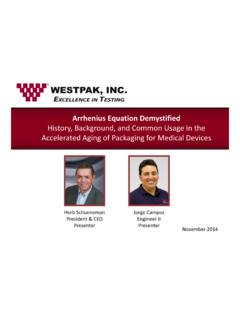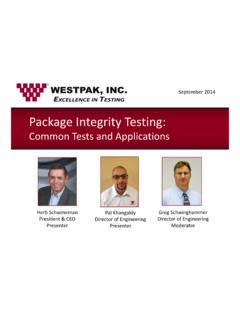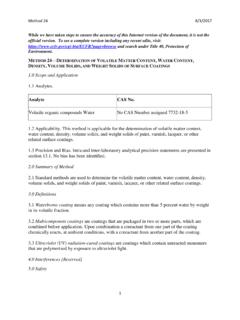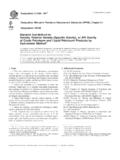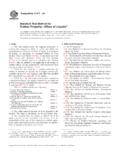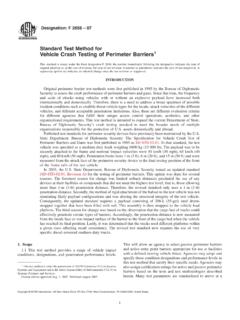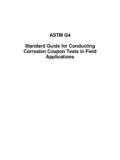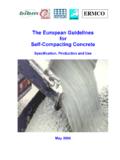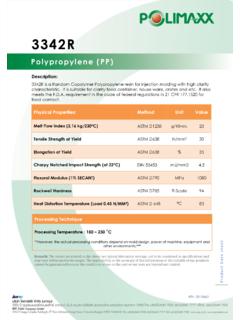Transcription of ASTM D4169: A Historical Perspective, Plus Review …
1 October 2016 Herb Schueneman Chairman of the Board astm D4169: A Historical perspective , Plus Review and Implications of D4169-16 Tres Wood, CPP(L), CPLP-II Test Engineer I 2 Agenda 1) astm D4169 - Historical perspective Review of Protective Package Testing Protocols, pre- astm D4169 Overview and Significance of D4169 s Initial Release Comments on Test Industry Acceptance of the Original Document 3 Agenda (cont.) 2) astm D4169-16 Overview and Significance of D4169-16 Comparison of Test Inputs D4169-14 vs D4169-16 What Changed, What Didn t, and Why Commentary on the 16 Revision Steps To Take if Products or Packages Fail the 16 Revision Protective Packaging Test Protocols pre- astm D4169 4 1950 s (and prior) NSTA 1 & 1A Dated, often used but seldom validated, used unrealistic test methods & FED-STD-101: Test Procedures for Packaging Materials Probably initiated in the 50s, widely used for military hardware, revised 3 times until the mid 80s, folded into MIL-STD-3010 MIL-HDBK-304.
2 Package Cushioning Design Originally an Air Force doc, good information but not widely used Protective Packaging Test Protocols pre- astm D4169 5 1960 s Advent of Scientific Packaging MSU s School of Packaging - Dr. Jim Goff Application of military methods & procedures to commercial products Damage Boundary shock testing: astm D3332 Vibration test methods & design procedures: astm D3580 & similar Protective Packaging Test Protocols pre- astm D4169 6 1970 s Work begins on the 1st Pre-Shipment Package Performance Test Protocol astm Subcommittee known as The Ostrem Group Core members: Fred Ostrem, Dunc Godshall, Sergei Guins, Dennis Young, Bob Fiedler Lots of give & take, fervent exchange of ideas Ten years of investigation & negotiations Breakthrough was the 2+ hour phone call: Godshall & Young Draft document survived the scrutiny of the entire D10 Committee, required for a consensus document Bob Fiedler D.
3 E. Young Significance of D4169 s Initial Release 7 1980 s Here is what this document meant to the Package Testing community: A good understanding of how a packaged product will arrive at a customer s location prior to shipment A scientifically valid method of bringing the distribution environment into the test laboratory A test protocol based on other existing documents that didn t require any new or non-existing equipment, documents, or procedures Significance of D4169 s Initial Release 8 1980 s (cont.) A method of handling the wide variations in product sensitivities, distribution environment variables, identification of hazards , proper sequencing of hazards Procedures for dealing with vastly different transportation vehicles and lading on those vehicles A true consensus document satisfactory to (fussy) gov agencies (FDA, etc.)
4 Industry Acceptance of D4169 9 1982 Acceptance was immediate and almost overwhelming (!) Huge affect on packaging materials, designs, etc. Opened new doors to marketers using the package as the primary product selling agent D4169 Brief Change History 10 astm D4169-82 Early history & revisions: oFirst printing: 1982 oFirst revision: 1984 oSecond revision: 1986 7 pages, 17 DCs, 11 ref Docs, 9 Hazard Elements, 3 ALs, sine sweep vibration D4169: Brief Change History 11 Rev Pgs DCs Ref Docs Hazard Elements ALs Vibration Significant Changes -86 7 17 11 9 3 Sine Sweep, 3 ALs, 180 min Editorial -88 8 18 11 8 3 Random, 3 veh, 3 AL s 180 min Added Random, DC 18 (Gov proc) -99 11 18 14 8 3 Random, 3 veh, 3 ALs, 180 min -01 11 18 14 8 3 same -04a 12 18 15 9 3 same Add Alt. test, DC2 test plan exam in Appendix -05 12 18 16 9 3 same Fork lift handling 19 years D4169: Brief Change History (cont d) 12 Rev Pgs DCs Ref Docs Hazard Elements ALs Vibration Significant Changes -08 14 18 20 10 3 Same - Random Added Conc.
5 Impact D6344, mod FL Handling, editorial -09 15 18 20 10 3 same Mod to DC 18, other edit changes .. -14 16 18 21 10 3 same # of impacts, 3 axis vibe, other editorial -16 17 18 21 10 Vibe portion changed All truck profiles changed Added summary of changes from previous version 8 years 13 QUESTIONS astm D4169-16: Why the Change? The 2016 version is the latest step in the ongoing evolution of laboratory simulation testing of products and their protective package systems. 14 Hydraulic Vibration Machines WESTPAK, San Jose, CA astm D4169-16: Why the Change? With the increased availability and lower costs of data recorder equipment, we have a much better understanding of the stresses products and packages are exposed to in the distribution environment. This increased understanding has been reflected in past revisions of various package and product test protocols.
6 astm D4169 had not changed their vibration profiles in so long that many considered them to be settled science when in fact, they weren t. 15 16 astm D4169-16: Why the Change? Too many times we hear, I don t understand it - we passed all the lab tests, but we re still having problems in the field. Then the tests are wrong! The opposite can also happen, We don t have any damage in shipment, but we can t pass the laboratory tests. Then the tests are wrong! Bill Kipp, speaking in 2008 .. Bill Kipp astm D4169-16: Why the Change? 17 Here are just two examples of what real-life vibration looks like on American roads: These plots are compilations of multiple recordings of shock and vibration in transit. Green signifies that a particular event occurred at that frequency/severity. Yellow indicates more events occurred at those frequencies/severities.
7 Orange/red shows where the majority of events occurred. Note similar waveforms. astm D4169-16: Why the Change? 18 The blue lines on these graphs indicate the probability of a particular vibration event. The top blue line represents that 100% of all events occurred below that level. Working down, the blue lines below it indicate 99%, 95%, 90% and 80% probabilities of occurrence. 99% 95% 90% 80% 100% Probability of Occurrence astm D4169-16: Why the Change? 19 In a nutshell, this is why the change was made: When comparing the average intensity of real-world truck transportation (the thick blue line) against the classic astm truck profiles (red, yellow and green lines), the mis-match is quite obvious. What Is the Change? New Combined Truck Spectrum Vibration: Does it look a bit more familiar now?
8 20 all three Assurance Levels Where Are My Assurance Levels? The new spectrum combines all three Assurance Levels Based on the spectrum found in existing test procedures astm D7386-16 & ISTA 3A. The goal is to more closely model real-world vibration actually encountered and measured on US and European roads. Builds on the work of Bill Kipp, astm Committee D10, & ISTA. 21 astm D4169-14 DC3 astm D4169-16 Truck Vibration Changes * astm D4169-16 DC3 180 minutes divided amongst all possible shipping orientations o60 minutes per axis Profile based on Assurance Level I, II, or III 180 minutes divided amongst all possible shipping orientations oUp to 3 axes All the following High, Medium, and Low level Truck profiles tested (no assurance levels) oLow Level: 120 minutes (40 minutes per axis) oMedium Level: 45 minutes (15 minutes per axis) oHigh level: 15 minutes (5 minutes per axis) * NOTE: Only the TRUCK profile is affected; there are no changes to any other testing schedules.
9 astm D4169-14 DC13 astm D4169-16 DC 13 180 total minutes o60 minutes truck o120 minutes air oDivided amongst all possible shipping orientations Truck: 20 min each base, side, end Air: 40 min each base, side, end Profiles based on Assurance Level I, II, or III 180 minutes divided amongst all possible shipping orientations oUp to 3 axes 60 minutes truck 120 minutes air All the following High, Medium, and Low level Truck profiles tested (No assurance levels) oTruck Low Level: 40 minutes (13 min, 20 sec per axis) oTruck Medium Level: 15 minutes (5 min per axis) oTruck High level: 5 minutes (1 min, 40 sec per axis) Air profile based on Assurance Level I, II, or III o40 minutes per axis * NOTE: Only the TRUCK profile is affected; there are no changes to any other testing schedules. astm D4169-16 Truck Vibration Changes * What Did Not Change?
10 There are no changes to the other test inputs. D10 Committee did clarify some wording and fix a few typos. 24 25 WESTPAK s Commentary on D4169-16 The science of transport vibration measurement and replication is alive and on-going. This change more closely aligns the truck vibration simulation with real-world data and with real customer experiences. We ve seen many of our 4169 clients (especially in the medical device arena) cutting back their truck vibration test level from AL I to AL II due to concerns over getting test results more severe than real-world results. The majority of this new multi-level Grms test occurs below the old AL II Grms levels. 26 Steps To Take If Products or Packages Fail D4169-16 From astm D4169-16, page 8: If more detailed information is available on the transport vibration environment or the shipping unit damage history, it is recommended that the procedure be modified to use such information.


